Navis shares survey of global container terminal trends
Nearly 60 Navis customers participated in the survey, representing a cross-section of container terminals around the world using various degrees of automation and AI to improve operations.

Navis, the Oakland, California-based provider of ocean cargo terminal operations for Cargotec Corporation, recently unveiled the results of its newest TechValidate customer survey the state of artificial intelligence (AI) as it relates to automated decision making.
According to the survey, 88% of respondents indicated that automated decision making will be very if not extremely important for the future of innovation at terminals. Further, 83% plan to increase their AI investments over the next one-to-three years, signaling growing confidence in the use of innovative technologies to improve terminal efficiencies and gain competitive advantages.
Nearly 60 Navis customers participated in the survey, representing a cross-section of container terminals around the world using various degrees of automation and AI to improve operations.
The survey asked Navis customers what they perceive as the most important benefits of automated decision-making. Improved consistency of operations and equipment utilization (86% each), both topped the list, followed by enabling teams to work smarter and faster (60%), improved safety (47%), better management of billable events (33%) and improved environmental compliance (12%).
Lastly, more than one third (39%) of respondents noted that automated decision-making could increase terminal productivity by as much as five-to-six moves per hour. A small percentage (2%) even believed productivity gains could be twice that rate—more than 10 moves per hour.
The survey findings indicate that container terminals, regardless of AI maturity, are increasingly aware of the possibilities of automated decision-making. According to respondents, container handling equipment (CHE) assignments (81%), decking (81%), action recommendations (69%), gate volume predictions (59%) and vessel stowage (52%) are among the many decisions customers believe could be automated with the help of AI.
“Just a few short years ago only a handful of our customers were even open to the idea of automation or other disruptive technologies designed to make the container terminal smarter, safer and more sustainable,” said Andy Barrons, Chief Strategy Officer, Navis. “The survey demonstrates just how far the industry has come – and will continue to go – in harnessing technology in the right ways to automate decision making within terminals. We firmly believe that automation and the use of AI is our future, and will continue to support our current and future customers as they embark down this critical path.”
In an interview with Logistics Management, Barrons said there are still some barriers to entry, however.
“By far, the largest barrier to widespread adoption/achieving business benefit of AI is ‘available skills on AI technology,’” he said. “Based on survey results, we can also see that data quality, data availability and relevant use cases with business benefit also major challenges. To overcome this barrier, our survey respondents indicated that they would look to augment their internal resources - either by leveraging their TOS provider or by utilizing other third party resources.”
Despite its potential, AI-driven automated decision-making continues to be an uphill battle for some. When asked to indicate their current phases of AI implementation, no one reported deploying a high level of AI within their operations. More than half (56%) reported being in learning or piloting phases while 11% noted having deployed some AI into terminal operations.
When asked to identify the biggest challenges to achieving the benefits of AI, respondents noted a lack of AI technology skills (68%), data quality (57%), relevant industry use cases with business outcomes (34%) and data availability (30%) among the top reasons.

Article Topics
Ports News & Resources
U.S.-bound import growth track remains promising, notes Port Tracker report Q&A: Port of Oakland Maritime Director Bryan Brandes Signs of progress are being made towards moving cargo in and out of Baltimore New Breakthrough ‘State of Transportation’ report cites various challenges for shippers and carriers in 2024 Industry experts examine the impact of Baltimore bridge collapse on supply chains Port of Baltimore closed indefinitely to ships after 1.6-mile Key Bridge collapses following maritime accident February and year-to-date U.S. import growth is solid, reports S&P Global Market Intelligence More PortsLatest in Logistics
Baltimore suing ship that crashed into bridge, closing port, costing jobs Intermodal growth volume remains intact in March, reports IANA Descartes announces acquisition of Dublin, Ireland-based Aerospace Software Developments Amid ongoing unexpected events, supply chains continue to readjust and adapt Shipment and expenditure decreases trend down, notes Cass Freight Index March trucking tonnage trends down, reports ATA FTR Shippers Conditions Index enters negative territory More LogisticsAbout the Author
Subscribe to Logistics Management Magazine

Find out what the world's most innovative companies are doing to improve productivity in their plants and distribution centers.
Start your FREE subscription today.
April 2023 Logistics Management

Latest Resources














